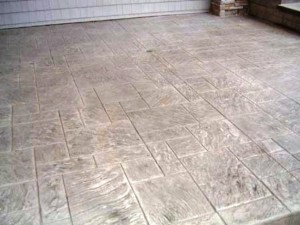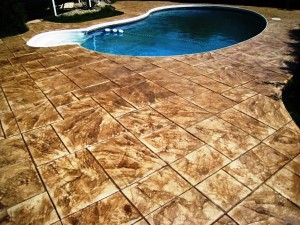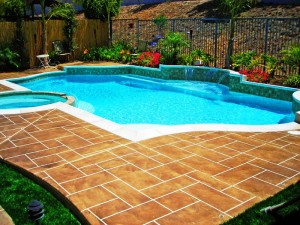Concrete Stamping or Stamped Concrete Overlays
Stamping is the process of creating a stone-like appearance on your existing concrete surface. After thoroughly prepping your surface, a thick overlay is poured onto the surface. The stone appearance is created by pressing a patterned mat into the texture while it is still soft. Textures such as granite, sandstone, pavers, wood and slate can be created.
Stamped Concrete Overlays are applied over the existing concrete surface. Unlike micro topping and spray down overlays the thickness of stamped overlay is determined by the requirements of the stamps being used.
Stamped overlays generally ranges from a quarter of an inch to half an inch thick. The stamped overlay is spread using a gauge rake with an adjustable depth to insure a uniform thickness. The overlay is then imprinted using stamps or texturing skins. Stamps are available in a wide range of patterns. Stamped Concrete Overlay mixes are usually designed to dry slower than other overlays so that whoever is doing the stamping has enough time to complete the project before the concrete has a chance to “set up”. Stamping provides a solid surface so there is no maintenance issues with weeds, mold, ants, replacing sand and resetting of shifting pavers.
Stamped Concrete Adds Value
The value of stamped concrete presents itself over and over again in all types of projects. From driveways, pool decks and patios to theme parks and malls, stamped concrete is chosen for its value improvements including reduced costs, an appealing final products, and easy maintenance. Along with the known durability and long-lasting feature of regular concrete, stamping adds a decorative touch making it a desirable and economical product for all.
Stamped concrete offers real benefits in terms of performance, cost savings, and aesthetics.
- Reduced long-term maintenance and care.
Over time, other surface materials such as pavers can become loose or settle, resulting in tripping hazards. Stamped concrete’s advantage is that it never needs resetting or replacing. It eliminates tripping hazards for parks, resorts, etc. - Increased longevity.
Your initial investment in stamped concrete is only part of the total equation. Concrete lasts longer than other materials, is durable in nearly every type of environment, and holds up better to traffic and wear. - Requires less maintenance.
Stamped concrete requires minimal maintenance than most other paving materials which can add up to big savings over the surface’s lifetime. - Increases resale value of property.
Stamped concrete adds instant curb appeal and aesthetic value to a property. You can maximize the return on your investment by choosing stamped concrete over plain concrete.
Compare Stamped Concrete to other paving materials and see first-hand how concrete stacks up to asphalt, natural stone, and precast pavers. You’ll be impressed with how much stamped concrete has to offer in terms of availability of patterns and colors, longevity and performance, speed of installation, customization, and more.
There are less expensive alternative to stamping that will also provide you pattern in your floor, Scoring and Stenciling.
What is scoring?
Scoring is the process of cutting a small groove on the surface of the concrete to create a desired pattern such as squares or diamonds. Normally these patterns are no smaller than 24” x 24” and require a minimum of an 8” border around the room to be scored. Scoring can beautifully accentuate a room by drawing the eye from one pattern to the other and is less expensive than stamped concrete.
What is a Concrete Stencil?
Concrete stenciling is a process which is used to create a pattern in a concrete overlay. When this process is done well, the result can be very aesthetically pleasing, creating the illusion of a tiled, cobblestone, or similarly patterned surface.
Stenciling is typically done with a wax impregnated paper in a roll that is pre-cut to patterns that can be selected from a catalog (stone, brick, etc.). The stencil is then wet set into the overlay. Then color hardener is cast over the concrete, troweled in, release agent is applied, and it is textured. The result is a realistic tile stone or brick look that is extremely durable due to the color hardener product. Stenciling can also be applied in an overlay with a sticky-back adhesive version of the stencil laid over the base coat (grout layer), then subsequent layers and colors are applied to again create unique and realistic looks.
Why Wait? Contact us today for a free estimate!
Are you wondering what it will take to transform your concrete floors? Contact us today! Give us a call at 813-818-7555 / 727-530-3555 or just click here to request your Free Estimate.



